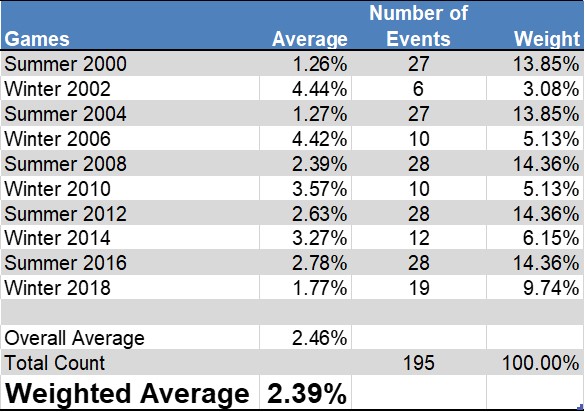Heuristics and Bias in Sales and Buyer Decision Making
Who doesn’t love a shortcut? We take hundreds of mental shortcuts daily. Our brains are downright lazy when faced with thousands of neurological...


What do the modern Olympic games and winning sales demos have in common? 2% That is the statistical difference between the average Gold Medal and Silver Medal in the Olympics. The same holds true for the decision a group of stakeholders makes between staying with their current solution, switching to yours or choosing a competitor. The reality is that any judged event will have a similar bias. Why is that?

Why is the gap so small, and why does this pattern exist? Based upon our research, the 2% Factor has everything to do with biases that occur during judged events. In fact, professional judges, such as Olympic judges, dog show judges, etc., train to reduce the effect of cognitive biases—but it's humanly impossible to eliminate them completely!
One key bias that skews results is known as "Systematic Errors in Decision Making," or people using heuristics in decision making. Heuristics are simple, efficient rules that are often used to form someone’s judgements and to help them make decisions. These are essentially shortcuts that involve focusing on one aspect of a complex problem and eliminating or ignoring others. Evolutionarily, heuristics allow humans to make snap decisions that could save their lives—fight or flight. We don't live in times where we are being chased by lions anymore, but our impeccable ability to make quick decisions in complex situations has remained.
Researchers Amos Tversky and Daniel Kahneman analyzed systematic bias and heuristics that serve as a mechanism for dealing with complex decisions. You might recognize Daniel Kahneman for his best-selling book Thinking Fast and Slow. Their research identified thirteen cognitive biases that come into play in an environment where an individual forms a judgment and makes a decision. Three of which stand out if you look at all thirteen biases and their relationship to software sales presentations and demos.
The first one is ease of recall. Individuals judge events with a bias towards the one that is most easily recalled. Meaning the stronger your demo is associated with something stakeholders are already familiar with, the more significant the bias’s impact is, and now you can use it in your favor. For example, if you are doing a demo, start by explaining what they are already doing, and then transition into how you can make it easier for them. That shows your product while including something they're familiar with making your demo stand out. Having the best Discovery methodology and skills enables you to uncover what is most important to the decision stakeholders and discuss, present or demonstrate improvements to the familiar, enabling their ease of recall bias. Ease of recall can further impact this bias by implementing a proven demonstration methodology and skills that organize the familiar into a flow that illuminates your solutions to the pain of the familiar.
The second key bias to consider is conjunctive and disjunctive event bias. We all tend to be biased towards overestimating the likelihood of conjunctive events, such as how a product feature could eventually lead to the achievement of an executive strategic initiative. In its simplest sense, we might demo something and say, "You can see how easy that is to accomplish, which leads to improvements in productivity, which results in you being able to achieve your revenue goals."
Similarly, we all tend to underestimate the probability of disjunctive events. We tend to assume things will go smoothly, which is a bias you can use in your favor for any selling event such as a demo. Suppose the demonstrator can create conjunctive events in the demo, in a way that flows logically, laying out the benefits on an organizational chart from the staff members up to the executives. In this case they are leveraging that bias. Your client success team can connect a positive aspect of the product to another area in their business to expand the use of your products using a connective structure, which means those positive assumptions will happen all throughout the presentation.
After training tens of thousands of people in sales engagement teams across the world, it has become clear that very few sales teams implement the power of the conjunctive bias, which always surprises us. When you use of this method for influence, you give yourself a distinct advantage over your competition.
This next bias is known as anchor adjustment. According to Loren Gary, the Associate Director of Leadership and Public Affairs at the Center of Public Leadership, Harvard Kennedy School, "In ambiguous situations, a trivial factor can have a profound effect on our decision if it serves as the starting point for which we make adjustments." This means that when a product demo is considered, a single product feature might seem insignificant to you as far as the overall solution and value, but in the eyes of the stakeholders, that single feature has a huge impact on their perspective and can seriously affect how they judge you against your competitors. If your Discovery uncovers some candidates for anchor adjustment bias, surround the demo of that feature with a great story. Many people think that in the professional setting of a demo, storytelling is only for salespeople when they open the event or present a case study. Not true! Storytelling is an excellent way to amplify the introduction of a demo topic where there is known anchor bias. We call this the “Opening Tell” of a Tell-Show-Tell demo topic. For example, it might be a story of all the steps they take today to accomplish a task that ends with hope. Now you demo to the hope (the Show) and finish with their new enlightened path to a pain-free future (the closing Tell). Having a solid storytelling methodology and base of story-styles puts you in an excellent position to positively affect the anchor adjustment bias.
It is all about how you establish value. Let us give you an example. Our sales engagement team was trying to secure a contract for a global rollout of our Success2Win program for Client Success to one of the largest technology firms in the world. We were competing with a variety of other soft-skills training companies. We introduced the insight that client success in large companies succeeds when they shift the thinking of the Client Success Managers (their title for someone who works with existing customers) from fielding and resolving day-to-day issues to establishing executive contact with clients. Executive contact means that the Client Success Managers can align the priorities of ongoing projects to each client’s top-level strategic initiatives.
Next, we provided examples of how Client Success Managers draw out those strategic initiatives from each client by asking the right kinds of Discovery questions, aligning their solutions to achieve those initiatives, and presenting their plan to the executives using storytelling techniques. We backed that up with video examples of key aspects of our training that supported our insights, and those videos were shared across our prospect’s executive team. We established our company's value—not in the features that our training offered, but in our unique expertise of knowing which problem they needed to solve (more alignment with their client’s executives). Some of our competitor’s training may have had the same features, but we anchored our unique value of our expertise in the stakeholders' minds, rather than relying solely on the features of our training components.
Providing a statistic around a feature is another example of anchoring. When presenting a set of product, service, or solution features, you simply summarize what was just demonstrated, and then provide a statistic for which the magnitude of productivity was improved. Now, whether they accept the number or not, you created an anchor point. Even if the stakeholders decide that a 40 percent improvement in productivity is too aggressive, we can always say, "Okay, well, let's say it was only half of that—you get an improvement of twenty percent in productivity. Think about how impactful that would be!"
By putting a number out there, a credible number achieved by another customer like them, you create an anchor. Now you get the benefit of the judging bias based upon that anchor. It has nothing to do with the competition at this point. Even if they're looking at your solution compared with what they already have, that anchor just created a bias over their own status quo.
The totality of these small additions to the way you present or represent your product or service will establish the biases you need to overcome the "2% Factor"—the difference between winning and losing.

Who doesn’t love a shortcut? We take hundreds of mental shortcuts daily. Our brains are downright lazy when faced with thousands of neurological...

In our most recent blog, we discussed the importance of utilizing a variety of available mediums to achieve maximum client satisfaction. Over the...

Are you ready 2Win in 2025? Assessing Organizational Fitness for 2Win! Global Training Is your organization ready for 2Win in 2025? 2Win training...